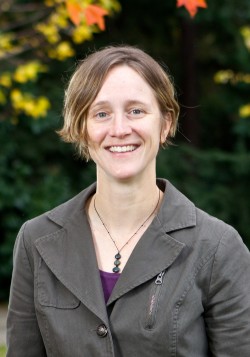
From city to city and across continents, barriers to communication are fewer than ever before. In an increasingly connected world, where the 24-hour news cycle reigns and a billion people are on Facebook, people have grown accustomed to instant, accessible information that spans the globe.
Kate Starbird, assistant professor at the UW’s College of Engineering, is exploring a new type of “digital volunteerism” that leverages social media as an online meeting place during crises. Emergency responders, as well as local and remote volunteers are using online platforms to gather, strategize, and work together to help those affected by disaster.
As part of the Surviving Disaster: Natural Hazards & Resilient Communities speakers series from the College of the Environment, UW Alumni Association, and the UW Graduate School, Starbird will give a free public lecture titled “Social media use during disaster events: The evolving role of the connected crowd in response and resilience” on Tuesday, October 27 at 7:30 p.m. RSVP TODAY!
In advance of that lecture, we caught up with Kate for a quick Q&A:
What do you hope attendees of your Surviving Disaster lecture walk away with?
“Attendees may be inspired to hear how people respond in pro-social ways to disaster events and about the role social media platforms are now playing in these activities. In recent disaster events, again and again, we see people—including those affected by the event as well as members of the remote crowd—appropriate social media platforms and other online tools to help themselves and help others.”
Why is this issue area especially important to focus on in 2015 and beyond?
“People all over the world are adopting mobile and internet-enabled devices that allow them to connect to others and seek and share information in new ways. These technologies are quickly becoming part of the critical infrastructure of disaster response. Amongst members of the public, these technologies open up new channels of communication and enable new kinds of collaborations to take shape after disaster events. They also present new challenges for emergency responders, who must develop new protocols for crisis-communication and collaboration in the age of peer production and many-to-many communication.”
What aspect of this issue rarely gets the attention it deserves?
“I think this issue—or rather this potential of social media use during disaster—has gotten considerable attention in recent years (but maybe I just don’t get out of my bubble much).”
What aspect of this issue is largely misunderstood by the general public?
“I think the question I get the most is: “Won’t social media be useless when the “big one” comes, because the phones won’t work?” Yet again and again, we see social media being used after events, facilitating collaborations between those affected and members of the remote crowd who can provide various kinds of assistance. Yes, for some events, there will be a time when the phones won’t work. Maybe a few hours or days. But re-establishing communication infrastructure is a priority for disaster response, and as soon as people can connect, they will start using online tools (often in new and creative ways) to meet the dynamic needs of a large-scale disaster event.”
What’s one thing people might be surprised to learn about you?
“I’ve been a bit over-exposed in my life—I’m pretty sure 15 minutes with Google would reveal just about everything there is to know about me.”
What are the three most important personality traits for someone in your line of work?
“This is tough. I think empathy is really important for doing research—especially qualitative research—on disaster events. We really have to approach each study with recognition that the events we are studying had (in many cases) catastrophic effects on people’s lives. Even though we tend to focus on the more positive aspects of disaster, i.e. people working together to survive and thrive afterwards, the context of this work is always quite sad. At every point in the study—data collection (especially interviews), data analysis, writing up papers, and giving presentations—we have to balance our enthusiasm for the research with the weight of the event and its impacts. So being able to empathize with those who are affected, even with folks who were not directly affected but who spent considerable time trying to help and are therefore emotionally impacted, is extremely important.”
What’s something you can’t believe you’re still up against?
“I feel like I’m just getting started as a researcher, so this question is tough. Ask me again in 10 years.”
What is the most exciting aspect of your current research?
“For my first few years in this space, we were documenting all the cool things every day people were doing with social media after disaster events, but formal emergency responders were still pretty reluctant (for good reasons) to adopt social media into their work. Only a few very early adopter responders had tiptoed into the space. But more recently, formal responders are recognizing that they need be on social media, and they’re reaching out to learn more about our research and actively trying to incorporate some of what we have learned into their strategies and protocols. This opens up whole new research areas, including questions around how formal responders can collaborate in new ways with the online crowd during events. All of this is very exciting.”

